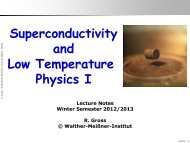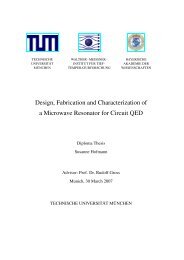Applied Superconductivity - Walther Meißner Institut - Bayerische ...
Applied Superconductivity - Walther Meißner Institut - Bayerische ...
Applied Superconductivity - Walther Meißner Institut - Bayerische ...
- No tags were found...
Create successful ePaper yourself
Turn your PDF publications into a flip-book with our unique Google optimized e-Paper software.
186 R. GROSS AND A. MARX Chapter 4This relation has been verified in many experiments.Beyond the intrinsic noise of the rf-SQUID one has to take into account the finite noise temperature T ampof the rf-amplifier. Furthermore, part of the coaxial line connecting the tank circuit to the preamplifieris at room temperature. Since the capacitance of the line and the preamplifier contribute a significantpart to the total capacitance of the tank circuit, part of the resistive damping of the tank circuit is wellabove the operation temperature of the SQUID. This adds additional noise which can be included intothe preamplifier noise by assuming an effective noise temperature Tamp. eff The noise energy by the extrinsiccircuit is given by 2πηk B Tamp/ω eff rf . 59 Together with the intrinsic noise (4.2.16) this results in an energyresolution ofε≃( πη 2 Φ 2 02L) 1+ 2πηk B Tampeff . (4.2.18)ω rfWe see that the energy resolution of the rf-SQUID scales as 1/ω rf . Therefore, it is obvious to increase thetank frequency. However, one has to bear in mind that also T amp increases with increasing frequency. Theenergy resolution of rf-SQUIDs operated at typical frequencies of a few 10 MHz is a few 10 −29 J/Hz. Thissensitivity has been improved by using higher resonance frequencies 60,61 and cold preamplifiers. 62,63For systems operating at frequencies up to 3 GHz and using high electron mobility transistors energysensitivities down to 3 × 10 −32 J/Hz have been obtained. 64Comparing (4.2.18) to (4.1.48) we see that the intrinsic energy resolution of the rf-SQUID can be roughlyapproximated by ε ∼ k B T /ω rf , whereas that of the dc SQUID is roughly ε = k B T /ω c . Here, ω c =2πI c R N /Φ 0 is the characteristic frequency, which typically ranges in the 100 GHz regime. This showsthat the better intrinsic energy resolution of the dc SQUID is mainly related to the fact that ω c ≫ ω rf .4.2.3 Practical rf-SQUIDsLow T c rf-SQUIDsRF-SQUIDs based on metallic low temperature superconductors are commercially available since theearly 1970s (notably from Biomagnetic Technologies (BTi) – formerly S.H.E. Corporation, QuantumDesign, and Tristan Technologies Inc.). The early rf-SQUIDs had a toroidal configuration machined fromNb. These devices are operated at a few 10 MHz and typically have a white noise energy of 5×10 −29 J/Hzand a 1/ f noise of roughly 10 −28 J/Hz at 0.1 Hz. Today rf-SQUIDs are fabricated in the same way asdc-SQUIDs using thin film technology. Energy sensitivities down to a few 10 −32 J/Hz have been achievedin the white noise regime.High T c rf-SQUIDsAfter the discovery of the high temperature superconductors rf-SQUIDs based on the cuprate superconductorshave been developed operating at 77 K. In order to increase the operation frequency conventional59 R.P. Giffard, J.C. Gallop, B.N. Petley, Prog. Quantum Electr. 4, 301 (1976).60 A. Long, T.D. Clark, R.J. Prance, M.G. Richards, Rev. Sci. Instrum. 50, 1376 (1979).61 J.N. Hollenhorst, R.P. Giffard, IEEE Trans. Magn. 15, 474 (1979).62 H. Ahola, G.H. Ehnholm, B. Rantala, P. Ostman, J. Low. Temp. Phys. 35, 313 (1979).63 M. Mück, Th. Becker, Ch. Heiden, Appl. Phys. Lett. 66, 376 (1995).64 J. Clarke, IEEE Trans. Electron. Devices 27, 1896 (1980).© <strong>Walther</strong>-Meißner-<strong>Institut</strong>
















